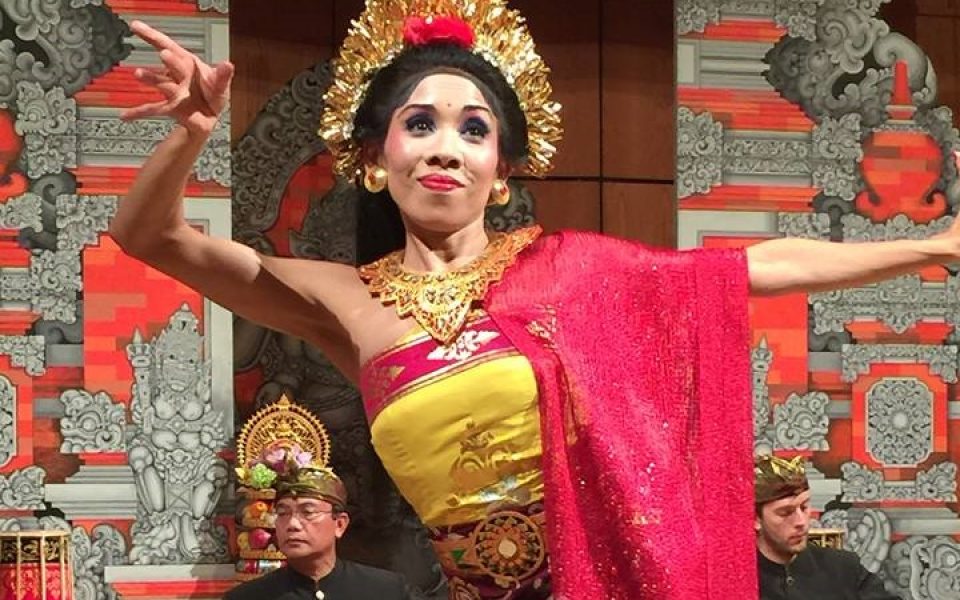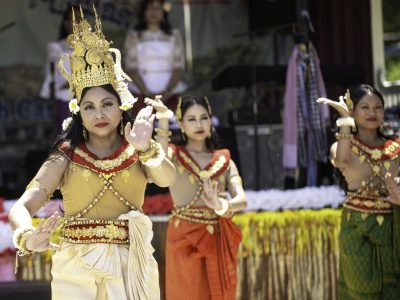by Anthony Harrison
I Madé Lasmawan, a stocky Balinese man dressed in black and gold, lit two sticks of incense and planted them in a pot next to delicate red flowers. Lasmawan chanted solemnly as the creamy, spicy aroma unexpectedly filled the room, and he tapped a small prayer bowl before ending with the mantra, Om, shanti, shanti, shanti. Be calm.
The impressive ritual, in all its reverence, was not necessarily a religious rite, but instead the naming ceremony of Wake Forest University’s gamelan ensemble, which had its inaugural performance in the Scales Fine Art Center in Winston-Salem last week.
For the uninitiated, gamelan is an Indonesian form of classical music, played largely by a percussion ensemble including gongs, cymbals and xylophone-like instruments.
Elizabeth Clendinning, an ethnomusicologist and the Wake Forest gamelan’s director, told Triad City Beat that she first learned about gamelan while studying for her doctorate at Florida State University.
“It’s been following me for a while,” Clendinning said.
Clendinning heard of Lasmawan, a preeminent gamelan teacher at Colorado College, while studying language in Indonesia.
“We met in eastern Bali,” Clendinning said. “I got on a motorcycle [and] drove all the way into the mountains to his family compound.”
Lasmawan and a small group of Balinese musicians teach gamelan to others outside of Indonesia, Clendenning said.
“I became a part of their community, and they have implanted themselves in the history and community here,” she said.
Lasmawan served as the conductor in the gamelan’s debut performance at Wake Forest University, leading Clendinning’s world music class and interested area musicians, some still in elementary school, from behind the kendang: a medium-sized, conga-looking drum typically used to set the tempo.
All performers dressed in traditional Balinese garb — men in gold shirts and black pants with golden caps; women adorned in gowns of gold and green, with flowers pinned to the side of their heads.
After the orchestra bowed with hands together and sat before their lavishly ornate, painted-wood instruments commissioned by the university, Lasmawan delivered a single pop of the kendang and the concert began.
Gamelan music lulls listeners into a trancelike state. The form is simultaneously intense and soothing. There’s a lot going on at all times, and the volume produced by all the pounded brass is rather impressive. But the instruments, struck by wooden mallets resembling either claw hammers or lint rollers, create bell-like tones that chime out unless dampened by the player’s left hand. The overtones meld together ethereally.
While the sound seems chaotic at first, the structure comes together when given a closer listen. Each beat is subdivided symmetrically, with the largest, deepest gong droning for the longest durations, smaller gongs playing a few beats quicker, the xylophone-type instruments chiming along at a trot and the crackling clatter of cymbals chopping the beat into the tiniest pieces.
Only Lasmawan’s kendang strayed from the even tempo, syncopating and accenting odd beats and holes in the timing, accelerating the corps into a gallop or slowing them down to a stroll.
For some pieces, dancers accompanied the music, bringing a brilliant visual element into synthesis with the spiritual aural experience.
Guest performer Ni Ketut Marni from Colorado College danced during the first number, “Pendet,” a welcome dance, joined by Clendinning. Both women were draped in robes dyed pistachio, saffron, gold and rose, with flashy crowns offset in the buns of their black hair. They danced with the posture of Hindu goddesses, with quirky head tilts, lightly fluttering fingers and angular arm and hip placements, occasionally flinging flower petals lightly from fringed bowls in their right hands.
Ryan Sutherland, another dancer, performed “Baris Tunggal,” a warrior dance, in severe makeup, a crown shaped like a silver spade and a coat of tapestry armor which splayed like wings with Sutherland’s wild twirls and stuttering, wide-kneed steps.
After Sutherland’s dance, Lasmawan addressed the audience.
“I named the gamelan ‘Giri Murti,’ which means ‘Magical Forest,’” Lasmawan said, relating his sense of surprise when he arrived at Wake, expecting a university and instead being plunged into the lush, literal forest on campus.
Lasmawan certainly had a sense of humor.
After one of Clendinning’s students demonstrated dampening technique, Lasmawan asked, “How long did you play gamelan?”
The student whispered.
“Just this semester?” he repeated with affected incredulity. “Very good.”
The concert ended with Lasmawan’s arrangement of the traditional, “Kecak Rama Sita,” a ballet depicting a story from the Hindu epic Ramayana. Choreographer Marni, Clendinning, Sutherland and Sammy Moorin featured as characters in the tale of kidnapping and the triumph of good over evil, accompanied by the Wake Forest University Concert Choir instead of the brassy ensemble.
But the choir transformed itself into a human gamelan under Lasmawan’s participatory guidance, all sections taking different phrases in the same even tempos and note values, Lasmawan a vocal kendang.
This combination of rhythmic intensity and simplicity makes gamelan delightful.
With the involvement of luminaries like Lasmawan, Clendinning hopes to continue the gamelan ensemble in the future, with concerts once a semester.
“[Gamelan] is infinitely fascinating and beautiful,” Clendinning said. “In 30 minutes, anyone can make good sounds, but it takes a whole lifetime to master.”
Her previous point was proven true, as everyone from toddlers to middle-aged attendees tapped the brass plates of the gamelan, forming a freestyle symphony.
Join the First Amendment Society, a membership that goes directly to funding TCB‘s newsroom.
We believe that reporting can save the world.
The TCB First Amendment Society recognizes the vital role of a free, unfettered press with a bundling of local experiences designed to build community, and unique engagements with our newsroom that will help you understand, and shape, local journalism’s critical role in uplifting the people in our cities.
All revenue goes directly into the newsroom as reporters’ salaries and freelance commissions.





Very interesting and fun.